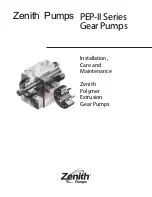
3.1 Connect the hydraulic ram, hose and
pump unit together, ensure that you
have securely fastened the couplers
before pumping.
Warning: inspect before each use. Do
not use if bent, broken, leaking,
damaged components or any suspect
parts are noted and /or it has been
subjected to a shock load.
3.2 Firmly close the release valve (P29)
by turning it clockwise.
3.3 Adjust the ram slowly to make the
load coaxial with the ram.
4.1 When not in use, store the equipment
in a dry location with the pump piston
(P20) and the ram fully retracted.
4.2 Periodically check the ram and pump
piston for signs of rust or corrosion.
Clean exposed areas with a clean
oiled cloth.
Warning; Never use sandpaper or
abrasive material on these surfaces!
4.3 A coating of light lubricating oil to
pivot points, axles and hinges will
help to prevent rust and assure that
pump assemblies move freely.
Periodically lubricate the pivot points,
axles and hinges with a light
lubricating oil as needed.
3. OPERATING INSTRUCTIONS
NOTE: The pump can be used in
any position from horizontal to
vertical. Always keep the hose end of
the pump downward when it is not
horizontal.
3.5 Pump the handle (p37) up and down
to supply pressure.
3.6 When work is done, SLOWLY and
CAREFULLY turn the release valve
counterclockwise (never more than
one turn) to release the pressure until
ram retracts to desired position.
4. MAINTENANCE
4.4 With ram fully lowed, set pump unit in
its normal, level position. Remove
the plug (p07) to check the hydraulic
oil level. If it is not adequate, add high
quality hydraulic jack oil as necessary.
Warning: DO NOT use brake fluid or
any other improper fluid and avoid
mixing different types of oil when
adding hydraulic oil.
4.5 To ensure best performance and
longer equipment life, replace the
complete hydraulic oil at least once a
year. With ram fully lowered, remove
the plug (P07).
4.6 Note: Dispose of hydraulic oil in
accordance with local regulations.
4.7 It is recommended that an annual
inspection be done by qualified
technicians.
Poor
performance
Ram will not
lift load
SYMPTOM
POSSIBLE CAUSES
CORRECTIVE ACTION
Release valve not tightly closed
Overload condition
Firmly closed release valve
remedy
Firmly close release valve
Replace ram and/or pump
Drain oil to proper level
Clean and lubricate
moving parts
Add hydraulic oil
Add hydraulic oil
Release valve not tightly closed
Hydraulic unit malfunction
Reservoir overfilled
Linkages binding
Oil level low
Oil level low
Ram will not
maintain load
Ram will not lower
after unloading
Ram will not extend
to full stroke
5. TROUBLESHOOTING
Summary of Contents for KN 7402-10PA
Page 5: ...7 DIAGRAMS Whote machine Pump...
Page 6: ...7 DIAGRAMS Ram Spreader...
Page 10: ...7 DIAGRAMAS Equipo Bomba...
Page 11: ...7 DIAGRAMAS Pist n Separador...
Page 12: ...www knova com mx...






























